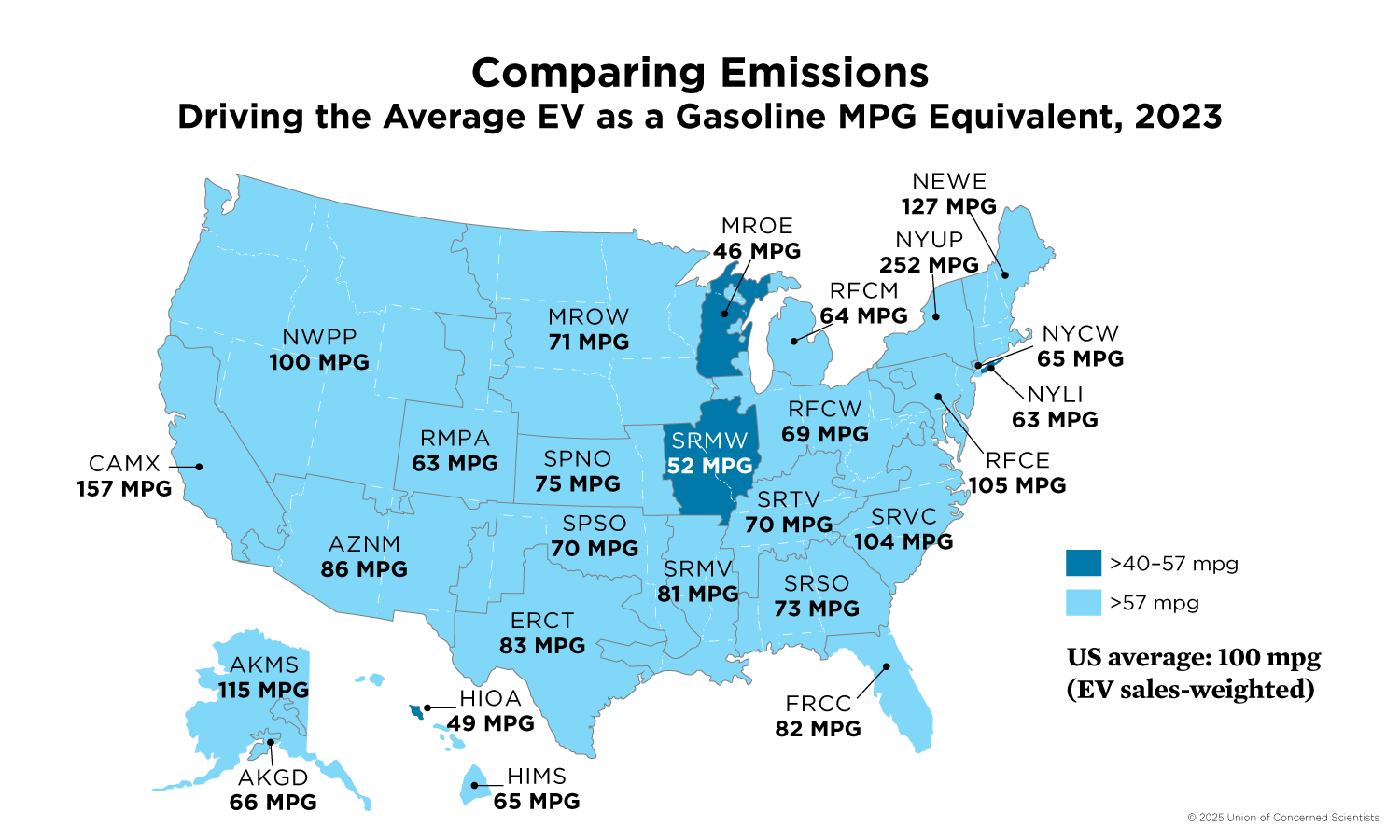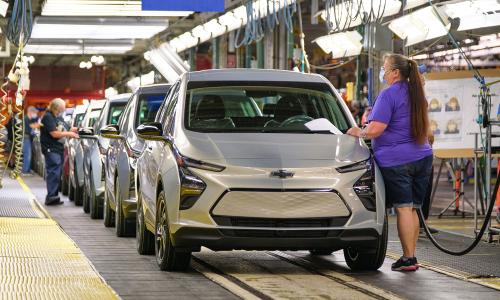Electric cars run at least partially on electricity. Unlike conventional vehicles that are only powered by gasoline or diesel, electric cars and trucks use an electric motor powered by electricity from batteries or a fuel cell.
In most cases this electricity is stored in a battery that is recharged from the grid, though in some cases a fuel cell is used to generate electricity from hydrogen. The key feature of an EV is that emission-free electric motors powered by clean and renewable energy sources can be used instead of burning gasoline or diesel in an engine.
Not all electric vehicles (or “EVs”) work the same way. "Plug-in hybrids" offer both a combustion engine and an electric motor: the motor is powered by a battery that can be recharged by plugging in while the conventional engine requires gasoline or diesel. Other EVs operate exclusively on electricity ("battery electric" vehicles). Still others power an electric motor by converting hydrogen gas into electricity "hydrogen fuel cell vehicles". Because fuel cell vehicles are currently only available in the US in limited numbers, the term “EV” is usually understood to refer to plug-in electric vehicles.
Conventional hybrid vehicles also have an electric motor, but aren’t considered EVs as they can’t be plugged-in. These hybrids recharge the battery by capturing energy during braking that would otherwise be lost, improving the vehicle’s efficiency. However, since all the energy for driving ultimately comes from burning gasoline or diesel, conventional hybrids don’t enable a switch from petroleum to clean, renewable energy sources.

In terms of air pollution and greenhouse gas emissions, electric cars and trucks are almost always cleaner than even the most efficient fossil-fuel powered vehicles. Exactly how clean depends on the type of vehicle and the source of the electricity. The average battery electric vehicle in the US now has greenhouse gas emissions from EVs are comparable to a car getting over 100 miles per gallon. When charged exclusively with renewable electricity like solar or wind, charging and operating an EV can be nearly emission free.
What kind of electric car should I consider?
If you're considering getting another car, it's a good idea to evaluate if that's truly necessary, especially if you have a multiple car household. You may be able to replace driving with some combination of walking, biking, an electric bike, and public transit. Not having a car avoids significant expenses like insurance, parking, fuel, and maintenance.
If you need a car, consider an EV, especially if you live in household where you have access to charging at home and multiple cars. EVs are part of the solution to limit climate change and improve air quality, while also reducing fuel and maintenance costs.
Whether you pick a fully electric vehicle, plug-in hybrid or gasoline-only car, choose a more efficient model that meets your mobility needs. It will be cheaper to fuel and produce lower emissions.
Plug-in hybrids can offer lower refueling costs compared to conventional vehicles and reduced climate-changing emissions. Because they are rechargeable from an outlet, they replace miles that would have been driven on gasoline with electricity, using the gasoline engine on longer trips. To use a plug-in hybrid effectively, drivers do need access to a place to park and plug-in, though a standard grounded 120V outlet is often sufficient. While plug-in hybrids can reduce gasoline use, their benefits are linked to drivers’ ability to recharge. If a plug-in hybrid isn’t recharged from the grid, it essentially operates as a conventional hybrid. Also, plug-in hybrids are often less efficient than fully-electric cars. Plug-in hybrid owners will need to do maintenance such as oil changes on the gasoline engine just like a conventional vehicle. Despite these potential drawbacks, drivers that plug in regularly can save money and reduce emissions, especially if infrequently taking long trips that require gasoline fill-ups. Learn more about how plug-in vehicles work.
Battery-electric cars use electricity as their only fuel, so they have no tailpipe emissions or gasoline use. Most battery-electric vehicle owners will recharge at home but recharging away from home is becoming easier as public and workplace charging stations become more widely available. And since battery-electric cars have no engine, maintenance is much simpler than a conventional gasoline car. Along with climate and fuel savings benefits, the driving performance of fully-electric vehicles is often better than conventionally-powered vehicles. Electric motors are much quieter than engines and the instant torque of the motors means quicker acceleration than most gasoline vehicles. Learn more about how battery-electrics work.
Fuel cell vehicles are available in some locations, and particularly in California. These vehicles offer some benefits—including fast refueling times and long driving ranges—but also require hydrogen refueling stations, which at present aren't widely available. Very few passenger fuel cell vehicle models are currently available, but the technology may have applications for larger on road vehicles and non-road vehicles that may be difficult to electrify with batteries such as marine and aviation applications. Learn more about how fuel cells and fuel cell vehicles work.
Conventional hybrids hybrids may also make sense in cases where current electric car models don’t match a driver’s needs. Hybrids retain the range and gasoline refueling of conventional vehicles, while offering the increased efficiency compared to a similar non-hybrid model. Since they derive all their power from gasoline or diesel, non-plug-in hybrids aren’t considered electric vehicles Learn more about how hybrids work.




